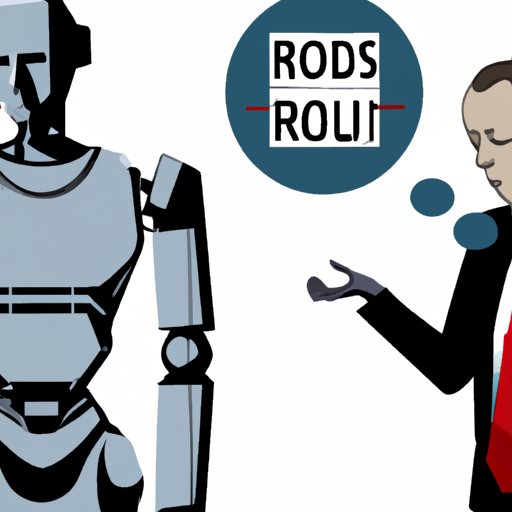Introduction
In recent years, there has been a growing debate about the potential of robots replacing humans in the workplace. This concept is known as “automation” and refers to the process of using machines, computers, or other technology to perform tasks that were previously done by humans. Automation is becoming increasingly popular in many industries, from manufacturing to healthcare, and its impact on the workforce is far-reaching. In this article, we will explore the pros and cons of automation in the workplace, the technological advances necessary for a robot-dominated workforce, the potential impact on job security, the ethical considerations of robots replacing humans, and the effects on employee morale.
Pros and Cons of Robots Replacing Humans
One of the primary benefits of automation is increased efficiency. By using machines to perform repetitive tasks, companies can save time and money and produce higher quality products. Additionally, automated processes can reduce errors and increase accuracy, resulting in improved customer satisfaction. According to a study by the International Federation of Robotics, “By automating production processes, companies are able to reduce costs and improve productivity. This leads to higher profits, which can be reinvested in research and development, creating jobs in other areas.”
However, there are also some potential drawbacks to automation. One of the most significant concerns is the potential for job loss. As machines take over more and more tasks, fewer people may be needed to do the same amount of work. This could lead to widespread unemployment and decreased economic growth. Additionally, there are ethical considerations to think about when it comes to robots replacing humans. Machines lack the ability to make moral or ethical decisions, so certain tasks may be better suited to human workers.
Technological Advances Necessary for a Robot-Dominated Workforce
To create a robotic workforce, there must be technological advancements in several key areas. Automation and artificial intelligence (AI) are two of the most important technologies for this purpose. Automation involves using machines to complete tasks that were previously done by humans, while AI involves programming machines with the ability to learn and make decisions on their own. Robotics, machine learning, and data analysis are also important technologies that enable robots to complete complex tasks.

Potential Impact on Job Security
As robots become more prevalent in the workplace, there is a potential for long-term job losses. Although some jobs may be replaced by machines, others may be displaced as companies shift their focus to automation. This could lead to a decrease in wages and an increase in job insecurity. Additionally, automation may also reduce the need for certain skills, such as manual labor or problem-solving, leading to further job displacement.

Ethical Considerations of Robots Replacing Humans
When considering the use of robots in the workplace, there are several ethical considerations to keep in mind. For example, safety is a major issue – if robots are used in hazardous environments, they must be programmed to avoid harming humans. Additionally, robots may lack the ability to make moral or ethical decisions, which could lead to unintended consequences. Finally, robots may also reduce the need for human interaction in the workplace, leading to a decrease in job satisfaction and morale.
Effects on Employee Morale
The introduction of robots into the workplace could have a negative effect on employee morale. Studies have shown that employees who fear job loss due to automation may experience decreased job satisfaction and motivation. Additionally, robots may be seen as a threat to job security, leading to feelings of anxiety and uncertainty among workers.
Role of Human Workers in a Robot-Driven Workplace
Despite the potential for job loss due to automation, there are still roles that human workers can play in a robot-dominated workplace. For example, humans can transition to new roles, such as overseeing the robots or providing technical support. Additionally, humans can enhance robot performance by providing feedback and insight into how the robots can be improved.

Current Examples of Automation in the Workplace
Automation is already being used in a variety of industries, from manufacturing to healthcare. In manufacturing, robots are used to automate assembly lines and perform precision tasks. Autonomous vehicles are also becoming increasingly popular and are being used to transport goods and people. In healthcare, artificial intelligence is being used to diagnose diseases, monitor patients, and provide advice to medical professionals.
Conclusion
Robots replacing humans in the workplace is a complex issue with both pros and cons. On one hand, automation can increase efficiency and cost savings, but on the other hand, it could lead to job losses and ethical considerations. Technological advances, such as automation and artificial intelligence, are necessary for a robotic workforce, and human workers may need to transition to new roles in order to stay relevant. Automation is already being used in a variety of industries, and its impact on the workforce will continue to evolve in the coming years.
(Note: Is this article not meeting your expectations? Do you have knowledge or insights to share? Unlock new opportunities and expand your reach by joining our authors team. Click Registration to join us and share your expertise with our readers.)
